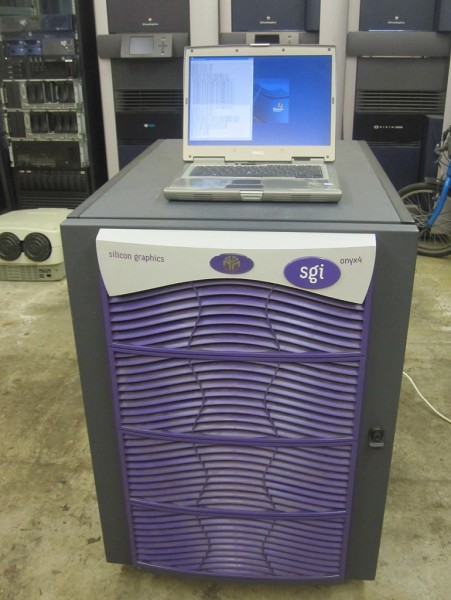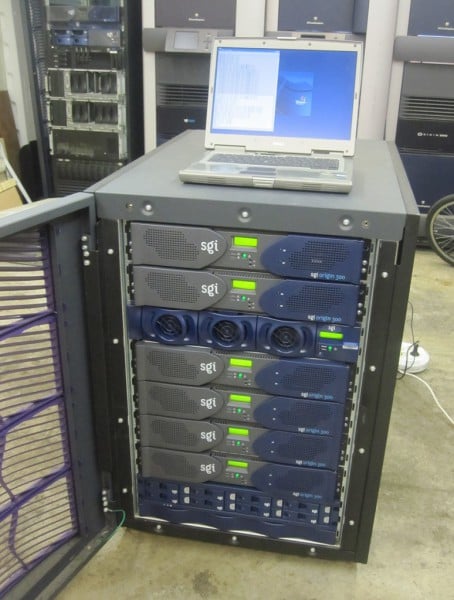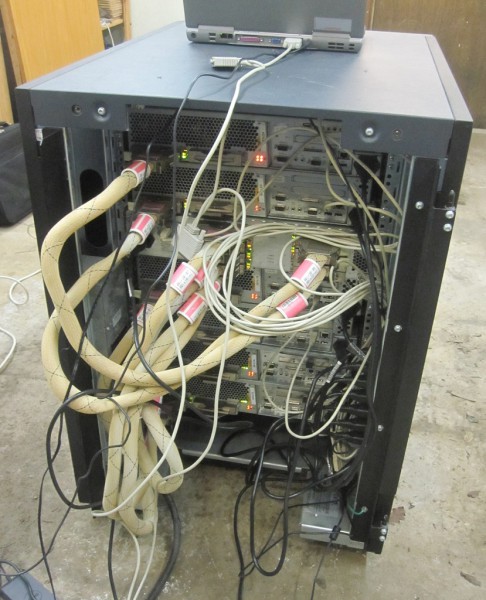Thank you.
I have just replaced the faulty mainboard in module 001c16, and now all 24 cpus are working

I had my eye on one on eBay, and also got a tip about it from jan-jaap.
I first tried to just swap the VRMs and IO9 from another module, but it didn't help, so it was the mainboard after all.
Unfortunately there is also some problem with one of the DIMMs, which causes me to "loose" 2GB. So now I have to find a replacement 1GB DIMM. Has anyone a leftover?
Code:
************************************************
TOO MANY ERRORS IN MAIN MEMORY TEST: DimmPair: 1
DIMMs: 2 & 3
Bank: 1
There were 4 errors found.
mtest_bank_main failed: Base Address
RSLT mtest_bank_mai FAIL diag_rc = 43 Base Address
TOO MANY ERRORS DURING MEMORY BIST: DimmPair: 1
DIMMs: 2 & 3
Bank: 1
There were 8 errors found.
mtest_bank_bist failed:
RSLT mtest_bank_bis FAIL diag_rc = 48
Disabling the failed bank
Regarding power consumption, it is like this:
Code:
Power on router+L2 44W
Power on all,but in standby 90W
Power on all 1270W
After boot 1360W
Four disks in TP900 110W
There is no load on the cpus in this measurements. Maybe I'll check power consumption again when I do some benchmarking.
Anyway here are updated hinv's and some more information.
Short hinv
Code:
O300 1# hinv
24 600 MHZ IP35 Processors
CPU: MIPS R14000 Processor Chip Revision: 2.4
FPU: MIPS R14010 Floating Point Chip Revision: 2.4
Main memory size: 22528 Mbytes
Instruction cache size: 32 Kbytes
Data cache size: 32 Kbytes
Secondary unified instruction/data cache size: 4 Mbytes
Integral SCSI controller 10: Version Fibre Channel QL2310
Integral SCSI controller 4: Version Fibre Channel QL2310
Integral SCSI controller 11: Version QL12160, low voltage differential
Integral SCSI controller 12: Version QL12160, low voltage differential
Integral SCSI controller 13: Version QL12160, low voltage differential
Integral SCSI controller 14: Version QL12160, low voltage differential
Integral SCSI controller 15: Version QL12160, low voltage differential
Integral SCSI controller 16: Version QL12160, low voltage differential
Integral SCSI controller 8: Version QL12160, low voltage differential
Integral SCSI controller 9: Version QL12160, low voltage differential
Integral SCSI controller 0: Version QL12160, single ended
Disk drive: unit 1 on SCSI controller 0
Integral SCSI controller 1: Version QL12160, low voltage differential
Disk drive: unit 1 on SCSI controller 1
Disk drive: unit 2 on SCSI controller 1
Disk drive: unit 3 on SCSI controller 1
Disk drive: unit 4 on SCSI controller 1
Integral SCSI controller 17: Version QL12160, low voltage differential
Integral SCSI controller 18: Version QL12160, low voltage differential
IOC3/IOC4 serial port: tty9
IOC3/IOC4 serial port: tty10
IOC3/IOC4 serial port: tty11
IOC3/IOC4 serial port: tty13
IOC3/IOC4 serial port: tty12
IOC3/IOC4 serial port: tty14
IOC3/IOC4 serial port: tty3
IOC3/IOC4 serial port: tty4
IOC3/IOC4 serial port: tty7
IOC3/IOC4 serial port: tty8
IOC3/IOC4 serial port: tty15
IOC3/IOC4 serial port: tty16
Gigabit Ethernet: tg1, module 001c16, PCI bus 2 slot 2
Fast Ethernet: ef2, version 1, module 001c14, pci 4
Fast Ethernet: ef3, version 1, module 001c18, pci 4
Fast Ethernet: ef4, version 1, module 001c22, pci 4
Fast Ethernet: ef1, version 1, module 001c24, pci 4
Integral Fast Ethernet: ef0, version 1, module 001c12, pci 4
Fast Ethernet: ef5, version 1, module 001c16, pci 4
Iris Audio Processor: version EMU revision A4, number 1
IOC3/IOC4 external interrupts: 3
IOC3/IOC4 external interrupts: 4
IOC3/IOC4 external interrupts: 5
IOC3/IOC4 external interrupts: 2
IOC3/IOC4 external interrupts: 1
IOC3/IOC4 external interrupts: 6
USB controller: type OHCI
USB controller: type OHCI
USB controller: type OHCI
USB controller: type OHCI
USB controller: type OHCI
USB controller: type OHCI
Long hinv
Code:
O300 2# hinv -vm
Location: /hw/module/001c12/node
IP45_4CPU Board: barcode MPX630 part 030-1797-001 rev -B
Location: /hw/module/001c12/Ibrick/xtalk/14
IO8 Board: barcode MPZ202 part 030-1673-004 rev -C
Location: /hw/module/001c12/Ibrick/xtalk/15
IO8 Board: barcode MPZ202 part 030-1673-004 rev -C
Location: /hw/module/001c14/node
IP45_4CPU Board: barcode MPX638 part 030-1797-001 rev -B
Location: /hw/module/001c14/Ibrick/xtalk/14
IO8 Board: barcode MPZ212 part 030-1673-004 rev -C
Location: /hw/module/001c14/Ibrick/xtalk/15
IO8 Board: barcode MPZ212 part 030-1673-004 rev -C
Location: /hw/module/001c16/node
IP45_4CPU Board: barcode MRB025 part 030-1797-001 rev -B
Location: /hw/module/001c16/Ibrick/xtalk/14
IO8 Board: barcode MPA329 part 030-1673-004 rev -C
Location: /hw/module/001c16/Ibrick/xtalk/15
IO8 Board: barcode MPA329 part 030-1673-004 rev -C
Location: /hw/module/001c18/node
IP45_4CPU Board: barcode MPX653 part 030-1797-001 rev -B
Location: /hw/module/001c18/Ibrick/xtalk/14
IO8 Board: barcode MRE740 part 030-1673-004 rev -C
Location: /hw/module/001c18/Ibrick/xtalk/15
IO8 Board: barcode MRE740 part 030-1673-004 rev -C
Location: /hw/module/001c22/node
IP45_4CPU Board: barcode MPX659 part 030-1797-001 rev -B
Location: /hw/module/001c22/Ibrick/xtalk/14
IO8 Board: barcode MRE719 part 030-1673-004 rev -C
Location: /hw/module/001c22/Ibrick/xtalk/15
IO8 Board: barcode MRE719 part 030-1673-004 rev -C
Location: /hw/module/001c24/node
IP45_4CPU Board: barcode MPX656 part 030-1797-001 rev -B
Location: /hw/module/001c24/Ibrick/xtalk/14
IO8 Board: barcode MRG051 part 030-1673-004 rev -C
Location: /hw/module/001c24/Ibrick/xtalk/15
IO8 Board: barcode MRG051 part 030-1673-004 rev -C
Location: /hw/module/001r20/router
ROUTER Board: barcode MAN493 part 030-1634-003 rev -A
24 600 MHZ IP35 Processors
CPU: MIPS R14000 Processor Chip Revision: 2.4
FPU: MIPS R14010 Floating Point Chip Revision: 2.4
CPU 0 at Module 001c12/Slot 0/Slice A: 600 Mhz MIPS R14000 Processor Chip (enabled)
Processor revision: 2.4. Scache: Size 4 MB Speed 300 Mhz Tap 0xa
CPU 1 at Module 001c12/Slot 0/Slice B: 600 Mhz MIPS R14000 Processor Chip (enabled)
Processor revision: 2.4. Scache: Size 4 MB Speed 300 Mhz Tap 0xa
CPU 2 at Module 001c12/Slot 0/Slice C: 600 Mhz MIPS R14000 Processor Chip (enabled)
Processor revision: 2.4. Scache: Size 4 MB Speed 300 Mhz Tap 0xa
CPU 3 at Module 001c12/Slot 0/Slice D: 600 Mhz MIPS R14000 Processor Chip (enabled)
Processor revision: 2.4. Scache: Size 4 MB Speed 300 Mhz Tap 0xa
CPU 4 at Module 001c14/Slot 0/Slice A: 600 Mhz MIPS R14000 Processor Chip (enabled)
Processor revision: 2.4. Scache: Size 4 MB Speed 300 Mhz Tap 0xa
CPU 5 at Module 001c14/Slot 0/Slice B: 600 Mhz MIPS R14000 Processor Chip (enabled)
Processor revision: 2.4. Scache: Size 4 MB Speed 300 Mhz Tap 0xa
CPU 6 at Module 001c14/Slot 0/Slice C: 600 Mhz MIPS R14000 Processor Chip (enabled)
Processor revision: 2.4. Scache: Size 4 MB Speed 300 Mhz Tap 0xa
CPU 7 at Module 001c14/Slot 0/Slice D: 600 Mhz MIPS R14000 Processor Chip (enabled)
Processor revision: 2.4. Scache: Size 4 MB Speed 300 Mhz Tap 0xa
CPU 8 at Module 001c16/Slot 0/Slice A: 600 Mhz MIPS R14000 Processor Chip (enabled)
Processor revision: 2.4. Scache: Size 4 MB Speed 300 Mhz Tap 0xa
CPU 9 at Module 001c16/Slot 0/Slice B: 600 Mhz MIPS R14000 Processor Chip (enabled)
Processor revision: 2.4. Scache: Size 4 MB Speed 300 Mhz Tap 0xa
CPU 10 at Module 001c16/Slot 0/Slice C: 600 Mhz MIPS R14000 Processor Chip (enabled)
Processor revision: 2.4. Scache: Size 4 MB Speed 300 Mhz Tap 0xa
CPU 11 at Module 001c16/Slot 0/Slice D: 600 Mhz MIPS R14000 Processor Chip (enabled)
Processor revision: 2.4. Scache: Size 4 MB Speed 300 Mhz Tap 0xa
CPU 12 at Module 001c18/Slot 0/Slice A: 600 Mhz MIPS R14000 Processor Chip (enabled)
Processor revision: 2.4. Scache: Size 4 MB Speed 300 Mhz Tap 0xa
CPU 13 at Module 001c18/Slot 0/Slice B: 600 Mhz MIPS R14000 Processor Chip (enabled)
Processor revision: 2.4. Scache: Size 4 MB Speed 300 Mhz Tap 0xa
CPU 14 at Module 001c18/Slot 0/Slice C: 600 Mhz MIPS R14000 Processor Chip (enabled)
Processor revision: 2.4. Scache: Size 4 MB Speed 300 Mhz Tap 0xa
CPU 15 at Module 001c18/Slot 0/Slice D: 600 Mhz MIPS R14000 Processor Chip (enabled)
Processor revision: 2.4. Scache: Size 4 MB Speed 300 Mhz Tap 0xa
CPU 16 at Module 001c22/Slot 0/Slice A: 600 Mhz MIPS R14000 Processor Chip (enabled)
Processor revision: 2.4. Scache: Size 4 MB Speed 300 Mhz Tap 0xa
CPU 17 at Module 001c22/Slot 0/Slice B: 600 Mhz MIPS R14000 Processor Chip (enabled)
Processor revision: 2.4. Scache: Size 4 MB Speed 300 Mhz Tap 0xa
CPU 18 at Module 001c22/Slot 0/Slice C: 600 Mhz MIPS R14000 Processor Chip (enabled)
Processor revision: 2.4. Scache: Size 4 MB Speed 300 Mhz Tap 0xa
CPU 19 at Module 001c22/Slot 0/Slice D: 600 Mhz MIPS R14000 Processor Chip (enabled)
Processor revision: 2.4. Scache: Size 4 MB Speed 300 Mhz Tap 0xa
CPU 20 at Module 001c24/Slot 0/Slice A: 600 Mhz MIPS R14000 Processor Chip (enabled)
Processor revision: 2.4. Scache: Size 4 MB Speed 300 Mhz Tap 0xa
CPU 21 at Module 001c24/Slot 0/Slice B: 600 Mhz MIPS R14000 Processor Chip (enabled)
Processor revision: 2.4. Scache: Size 4 MB Speed 300 Mhz Tap 0xa
CPU 22 at Module 001c24/Slot 0/Slice C: 600 Mhz MIPS R14000 Processor Chip (enabled)
Processor revision: 2.4. Scache: Size 4 MB Speed 300 Mhz Tap 0xa
CPU 23 at Module 001c24/Slot 0/Slice D: 600 Mhz MIPS R14000 Processor Chip (enabled)
Processor revision: 2.4. Scache: Size 4 MB Speed 300 Mhz Tap 0xa
Main memory size: 22528 Mbytes
Instruction cache size: 32 Kbytes
Data cache size: 32 Kbytes
Secondary unified instruction/data cache size: 4 Mbytes
Memory at Module 001c12/Slot 0: 4096 MB (enabled)
Bank 0 contains 1024 MB (Premium) DIMMS (enabled)
Bank 1 contains 1024 MB (Premium) DIMMS (enabled)
Bank 2 contains 1024 MB (Premium) DIMMS (enabled)
Bank 3 contains 1024 MB (Premium) DIMMS (enabled)
Memory at Module 001c14/Slot 0: 4096 MB (enabled)
Bank 0 contains 1024 MB (Premium) DIMMS (enabled)
Bank 1 contains 1024 MB (Premium) DIMMS (enabled)
Bank 2 contains 1024 MB (Premium) DIMMS (enabled)
Bank 3 contains 1024 MB (Premium) DIMMS (enabled)
Memory at Module 001c16/Slot 0: 2048 MB (enabled)
Bank 0 contains 1024 MB (Premium) DIMMS (enabled)
Bank 1 contains 1024 MB (Premium) DIMMS (enabled)
Bank 2 contains 1024 MB (Premium) DIMMS (disabled)
Bank 3 contains 1024 MB (Premium) DIMMS (disabled)
Memory at Module 001c18/Slot 0: 4096 MB (enabled)
Bank 0 contains 1024 MB (Premium) DIMMS (enabled)
Bank 1 contains 1024 MB (Premium) DIMMS (enabled)
Bank 2 contains 1024 MB (Premium) DIMMS (enabled)
Bank 3 contains 1024 MB (Premium) DIMMS (enabled)
Memory at Module 001c22/Slot 0: 4096 MB (enabled)
Bank 0 contains 1024 MB (Premium) DIMMS (enabled)
Bank 1 contains 1024 MB (Premium) DIMMS (enabled)
Bank 2 contains 1024 MB (Premium) DIMMS (enabled)
Bank 3 contains 1024 MB (Premium) DIMMS (enabled)
Memory at Module 001c24/Slot 0: 4096 MB (enabled)
Bank 0 contains 1024 MB (Premium) DIMMS (enabled)
Bank 1 contains 1024 MB (Premium) DIMMS (enabled)
Bank 2 contains 1024 MB (Premium) DIMMS (enabled)
Bank 3 contains 1024 MB (Premium) DIMMS (enabled)
ROUTER in Module 001c12/Slot 0: Revision 1: Active Ports [1,4,5,6,7,8] (enabled)
Integral SCSI controller 10: Version Fibre Channel QL2310, 66 MHz PCI
Integral SCSI controller 4: Version Fibre Channel QL2310, 66 MHz PCI
Integral SCSI controller 11: Version QL12160, low voltage differential
Integral SCSI controller 12: Version QL12160, low voltage differential
Integral SCSI controller 13: Version QL12160, low voltage differential
Integral SCSI controller 14: Version QL12160, low voltage differential
Integral SCSI controller 15: Version QL12160, low voltage differential
Integral SCSI controller 16: Version QL12160, low voltage differential
Integral SCSI controller 8: Version QL12160, low voltage differential
Integral SCSI controller 9: Version QL12160, low voltage differential
Integral SCSI controller 0: Version QL12160, single ended
Disk drive: unit 1 on SCSI controller 0 (unit 1)
Integral SCSI controller 1: Version QL12160, low voltage differential
Disk drive: unit 1 on SCSI controller 1 (unit 1)
Disk drive: unit 2 on SCSI controller 1 (unit 2)
Disk drive: unit 3 on SCSI controller 1 (unit 3)
Disk drive: unit 4 on SCSI controller 1 (unit 4)
Integral SCSI controller 17: Version QL12160, low voltage differential
Integral SCSI controller 18: Version QL12160, low voltage differential
IOC3/IOC4 serial port: tty9
IOC3/IOC4 serial port: tty10
IOC3/IOC4 serial port: tty11
IOC3/IOC4 serial port: tty13
IOC3/IOC4 serial port: tty12
IOC3/IOC4 serial port: tty14
IOC3/IOC4 serial port: tty3
IOC3/IOC4 serial port: tty4
IOC3/IOC4 serial port: tty7
IOC3/IOC4 serial port: tty8
IOC3/IOC4 serial port: tty15
IOC3/IOC4 serial port: tty16
Gigabit Ethernet: tg1, module 001c16, PCI bus 2 slot 2
Fast Ethernet: ef2, version 1, module 001c14, pci 4
Fast Ethernet: ef3, version 1, module 001c18, pci 4
Fast Ethernet: ef4, version 1, module 001c22, pci 4
Fast Ethernet: ef1, version 1, module 001c24, pci 4
Integral Fast Ethernet: ef0, version 1, module 001c12, pci 4
Fast Ethernet: ef5, version 1, module 001c16, pci 4
Iris Audio Processor: version EMU revision A4, number 1
PCI Adapter ID (vendor 0x1077, device 0x2300) PCI slot 2
PCI Adapter ID (vendor 0x14e4, device 0x1645) PCI slot 2
PCI Adapter ID (vendor 0x1102, device 0x0004) PCI slot 1
PCI Adapter ID (vendor 0x1102, device 0x7003) PCI slot 1
PCI Adapter ID (vendor 0x1102, device 0x4001) PCI slot 1
PCI Adapter ID (vendor 0x1077, device 0x2300) PCI slot 2
PCI Adapter ID (vendor 0x1077, device 0x1216) PCI slot 1
PCI Adapter ID (vendor 0x10a9, device 0x0003) PCI slot 4
PCI Adapter ID (vendor 0x11c1, device 0x5802) PCI slot 5
PCI Adapter ID (vendor 0x1077, device 0x1216) PCI slot 1
PCI Adapter ID (vendor 0x10a9, device 0x0003) PCI slot 4
PCI Adapter ID (vendor 0x1077, device 0x1216) PCI slot 1
PCI Adapter ID (vendor 0x11c1, device 0x5802) PCI slot 5
PCI Adapter ID (vendor 0x10a9, device 0x0003) PCI slot 4
PCI Adapter ID (vendor 0x11c1, device 0x5802) PCI slot 5
PCI Adapter ID (vendor 0x1077, device 0x1216) PCI slot 1
PCI Adapter ID (vendor 0x10a9, device 0x0003) PCI slot 4
PCI Adapter ID (vendor 0x11c1, device 0x5802) PCI slot 5
PCI Adapter ID (vendor 0x1077, device 0x1216) PCI slot 1
PCI Adapter ID (vendor 0x10a9, device 0x0003) PCI slot 4
PCI Adapter ID (vendor 0x11c1, device 0x5802) PCI slot 5
PCI Adapter ID (vendor 0x1077, device 0x1216) PCI slot 1
PCI Adapter ID (vendor 0x10a9, device 0x0003) PCI slot 4
PCI Adapter ID (vendor 0x11c1, device 0x5802) PCI slot 5
IOC3/IOC4 external interrupts: 3
IOC3/IOC4 external interrupts: 4
IOC3/IOC4 external interrupts: 5
IOC3/IOC4 external interrupts: 2
IOC3/IOC4 external interrupts: 1
IOC3/IOC4 external interrupts: 6
HUB in Module 001c12/Slot 0: Revision 2 Speed 200.00 Mhz (enabled)
HUB in Module 001c14/Slot 0: Revision 2 Speed 200.00 Mhz (enabled)
HUB in Module 001c16/Slot 0: Revision 2 Speed 200.00 Mhz (enabled)
HUB in Module 001c18/Slot 0: Revision 2 Speed 200.00 Mhz (enabled)
HUB in Module 001c22/Slot 0: Revision 2 Speed 200.00 Mhz (enabled)
HUB in Module 001c24/Slot 0: Revision 2 Speed 200.00 Mhz (enabled)
IP35prom in Module 001c12/Slot n0: Revision 6.210
IP35prom in Module 001c14/Slot n0: Revision 6.210
IP35prom in Module 001c16/Slot n0: Revision 6.210
IP35prom in Module 001c18/Slot n0: Revision 6.210
IP35prom in Module 001c22/Slot n0: Revision 6.210
IP35prom in Module 001c24/Slot n0: Revision 6.210
USB controller: type OHCI
USB controller: type OHCI
USB controller: type OHCI
USB controller: type OHCI
USB controller: type OHCI
USB controller: type OHCI
Additional information
Code:
O300 3# uname -aR
IRIX64 O300 6.5 6.5.30m 07202013 IP35
Code:
O300 4# scsicontrol -i /sev/scsi/*
/dev/scsi/sc0d1l0: Disk SGI IBM DGHS09Y 0190
ANSI vers 3, ISO ver: 0, ECMA ver: 0; supports: 16bit synch linkedcmds cmdqueing
Device is ready
/dev/scsi/sc1d1l0: Disk COMPAQ BD1468A4C5 HPB4
ANSI vers 3, ISO ver: 0, ECMA ver: 0; supports: 16bit synch linkedcmds cmdqueing
Device is ready
/dev/scsi/sc1d2l0: Disk COMPAQ BD1468A4C5 HPB4
ANSI vers 3, ISO ver: 0, ECMA ver: 0; supports: 16bit synch linkedcmds cmdqueing
Device is ready
/dev/scsi/sc1d3l0: Disk COMPAQ BD1468856B HPB2
ANSI vers 3, ISO ver: 0, ECMA ver: 0; supports: 16bit synch linkedcmds cmdqueing
Device is ready
/dev/scsi/sc1d4l0: Disk COMPAQ BD1468A4C5 HPB4
ANSI vers 3, ISO ver: 0, ECMA ver: 0; supports: 16bit synch linkedcmds cmdqueing
Device is ready
Code:
O300 5# /sbin/diskpatch -v
sc0d1l0: Disk SGI IBM DGHS09Y 0190 Serial: 68AE3DAA
sc1d1l0: Disk COMPAQ BD1468A4C5 HPB4 Serial: 3KA4J9AA
sc1d2l0: Disk COMPAQ BD1468A4C5 HPB4 Serial: 3KA416AA
sc1d3l0: Disk COMPAQ BD1468856B HPB2 Serial: D4AB0BAA
sc1d4l0: Disk COMPAQ BD1468A4C5 HPB4 Serial: 3KA4NFAA
Code:
M2100545-001-L2>serial all
001c12:
Data Location Value
------------------------------ ------------ --------
Local System Serial Number NVRAM M2100545
Reference System Serial Number Attached L2 M2100545
Local Brick Serial Number EEPROM MPX630
Reference Brick Serial Number NVRAM MPX630
EEPROM Product Name Serial Part Number Rev T/W
---------- -------------- ---------- -------------------- --- ------
NODE IP45_4CPU MPX630 030_1797_001 B 00
IO8 IO8 MPZ202 030_1673_004 C 00
EEPROM JEDEC Info Part Number Rev Speed (ns)
---------- ------------------------ ------------------ --- ----------
DIMM 0 CE000000000000000C322E00 M3 46L2820DT2-CA0 2D 10.0
DIMM 2 CE000000000000000C4A2E00 M3 46L2820DT2-CA0 2D 10.0
DIMM 1 CE000000000000000C332D00 M3 46L2820DT2-CA0 2D 10.0
DIMM 3 CE000000000000000C4C2E00 M3 46L2820DT2-CA0 2D 10.0
001c14:
Data Location Value
------------------------------ ------------ --------
Local System Serial Number NVRAM M2100545
Reference System Serial Number Attached L2 M2100545
Local Brick Serial Number EEPROM MPX638
Reference Brick Serial Number NVRAM MPX638
EEPROM Product Name Serial Part Number Rev T/W
---------- -------------- ---------- -------------------- --- ------
NODE IP45_4CPU MPX638 030_1797_001 B 00
IO8 IO8 MPZ212 030_1673_004 C 00
EEPROM JEDEC Info Part Number Rev Speed (ns)
---------- ------------------------ ------------------ --- ----------
DIMM 0 CE000000000000000C2A2E00 M3 46L2820DT2-CA0 2D 10.0
DIMM 2 CE000000000000000C342E00 M3 46L2820DT2-CA0 2D 10.0
DIMM 1 CE000000000000000C442E00 M3 46L2820DT2-CA0 2D 10.0
DIMM 3 CE000000000000000C3A2E00 M3 46L2820DT2-CA0 2D 10.0
001c16:
Data Location Value
------------------------------ ------------ --------
Local System Serial Number NVRAM M2100545
Reference System Serial Number Attached L2 M2100545
Local Brick Serial Number EEPROM MRB025
Reference Brick Serial Number NVRAM MRB025
EEPROM Product Name Serial Part Number Rev T/W
---------- -------------- ---------- -------------------- --- ------
NODE IP45_4CPU MRB025 030_1797_001 B 00
IO8 IO8 MPA329 030_1673_004 C 00
EEPROM JEDEC Info Part Number Rev Speed (ns)
---------- ------------------------ ------------------ --- ----------
DIMM 0 CE000000000000000C4E2E00 M3 46L2820DT2-CA0 2D 10.0
DIMM 2 CE000000000000000C542E00 M3 46L2820DT2-CA0 2D 10.0
DIMM 1 CE000000000000000C4B2E00 M3 46L2820DT2-CA0 2D 10.0
DIMM 3 CE000000000000000C462E00 M3 46L2820DT2-CA0 2D 10.0
001c18:
Data Location Value
------------------------------ ------------ --------
Local System Serial Number NVRAM M2100545
Reference System Serial Number Attached L2 M2100545
Local Brick Serial Number EEPROM MPX653
Reference Brick Serial Number NVRAM MPX653
EEPROM Product Name Serial Part Number Rev T/W
---------- -------------- ---------- -------------------- --- ------
NODE IP45_4CPU MPX653 030_1797_001 B 00
IO8 IO8 MRE740 030_1673_004 C 00
EEPROM JEDEC Info Part Number Rev Speed (ns)
---------- ------------------------ ------------------ --- ----------
DIMM 0 CE000000000000000C362E00 M3 46L2820DT2-CA0 2D 10.0
DIMM 2 7F7FFE00000000001200123D CM2201B 2 08.0
DIMM 1 CE000000000000000C422E00 M3 46L2820DT2-CA0 2D 10.0
DIMM 3 7F7FFE000000000012001231 CM2201B 2 08.0
001r20:
Data Location Value
------------------------------ ------------ --------
Local System Serial Number NVRAM M2100545
Reference System Serial Number Attached L2 M2100545
Local Brick Serial Number EEPROM MRF019
Reference Brick Serial Number NVRAM MRF019
EEPROM Product Name Serial Part Number Rev T/W
---------- -------------- ---------- -------------------- --- ------
POWER RPWR MRF019 030_1631_002 F 00
LOGIC ROUTER MAN493 030_1634_003 A 00
001c22:
Data Location Value
------------------------------ ------------ --------
Local System Serial Number NVRAM M2100545
Reference System Serial Number Attached L2 M2100545
Local Brick Serial Number EEPROM MPX659
Reference Brick Serial Number NVRAM MPX659
EEPROM Product Name Serial Part Number Rev T/W
---------- -------------- ---------- -------------------- --- ------
NODE IP45_4CPU MPX659 030_1797_001 B 00
IO8 IO8 MRE719 030_1673_004 C 00
EEPROM JEDEC Info Part Number Rev Speed (ns)
---------- ------------------------ ------------------ --- ----------
DIMM 0 CE000000000000000C532E00 M3 46L2820DT2-CA0 2D 10.0
DIMM 2 7F7FFE000000000012001826 CM2201B 2 08.0
DIMM 1 CE000000000000000C562E00 M3 46L2820DT2-CA0 2D 10.0
DIMM 3 7F7FFE000000000012001823 CM2201B 2 08.0
001c24:
Data Location Value
------------------------------ ------------ --------
Local System Serial Number NVRAM M2100545
Reference System Serial Number Attached L2 M2100545
Local Brick Serial Number EEPROM MPX656
Reference Brick Serial Number NVRAM MPX656
EEPROM Product Name Serial Part Number Rev T/W
---------- -------------- ---------- -------------------- --- ------
NODE IP45_4CPU MPX656 030_1797_001 B 00
IO8 IO8 MRG051 030_1673_004 C 00
EEPROM JEDEC Info Part Number Rev Speed (ns)
---------- ------------------------ ------------------ --- ----------
DIMM 0 CE000000000000000C5C2E00 M3 46L2820DT2-CA0 2D 10.0
DIMM 2 7F7FFE000000000012001702 CM2201B 2 08.0
DIMM 1 CE000000000000000C522E00 M3 46L2820DT2-CA0 2D 10.0
DIMM 3 7F7FFE000000000012001700 CM2201B 2 08.0
Code:
M2100545-001-L2>flash status
001c12:
Flash image B currently booted
Image Status Revision Built
----- ------------- ---------- -----
A valid 1.18.5 12/18/2002 08:58:31
B default 1.18.5 12/18/2002 08:58:31
001c14:
Flash image B currently booted
Image Status Revision Built
----- ------------- ---------- -----
A valid 1.18.5 12/18/2002 08:58:31
B default 1.18.5 12/18/2002 08:58:31
001c16:
Flash image A currently booted
Image Status Revision Built
----- ------------- ---------- -----
A user default 1.18.5 12/18/2002 08:58:31
B valid 1.18.5 12/18/2002 08:58:31
001c18:
Flash image B currently booted
Image Status Revision Built
----- ------------- ---------- -----
A valid 1.18.5 12/18/2002 08:58:31
B default 1.18.5 12/18/2002 08:58:31
001r20:
Flash image B currently booted
Image Status Revision Built
----- ------------- ---------- -----
A valid 1.18.5 12/18/2002 08:58:31
B default 1.18.5 12/18/2002 08:58:31
001c22:
Flash image B currently booted
Image Status Revision Built
----- ------------- ---------- -----
A valid 1.18.5 12/18/2002 08:58:31
B default 1.18.5 12/18/2002 08:58:31
001c24:
Flash image B currently booted
Image Status Revision Built
----- ------------- ---------- -----
A valid 1.18.5 12/18/2002 08:58:31
B default 1.18.5 12/18/2002 08:58:31
Code:
M2100545-001-L2>env
001c12:
Environmental monitoring is enabled and running.
Description State Warning Limits Fault Limits Current
-------------- ---------- ----------------- ----------------- -------
12V IO Enabled 10% 10.80/ 13.20 20% 9.60/ 14.40 12.19
12V DIG Enabled 10% 10.80/ 13.20 20% 9.60/ 14.40 12.06
5V Enabled 10% 4.50/ 5.50 20% 4.00/ 6.00 4.99
3.3V Enabled 10% 2.97/ 3.63 20% 2.64/ 3.96 3.34
5V aux Enabled 10% 4.50/ 5.50 20% 4.00/ 6.00 4.91
3.3V aux Enabled 10% 2.97/ 3.63 20% 2.64/ 3.96 3.37
2.5V Enabled 10% 2.25/ 2.75 20% 2.00/ 3.00 2.50
Speedo2 CPU Enabled 10% 1.44/ 1.76 20% 1.28/ 1.92 1.59
1.5V Enabled 10% 1.35/ 1.65 20% 1.20/ 1.80 1.49
Description State Warning RPM Current RPM
-------------- ---------- ----------- -----------
FAN 0 LEFT Enabled 2160 4007
FAN 1 CENTER Enabled 2160 4105
FAN 2 RIGHT Enabled 2160 4105
FAN 3 PS Enabled 2160 3116
FAN 4 PS' Enabled 2160 4488
Advisory Critical Fault Current
Description State Temp Temp Temp Temp
-------------- ---------- --------- --------- --------- ---------
NODE 0 Enabled 40C/104F 46C/114F 49C/120F 19C/ 66F
NODE 1 Enabled 40C/104F 46C/114F 49C/120F 19C/ 66F
001c14:
Environmental monitoring is enabled and running.
Description State Warning Limits Fault Limits Current
-------------- ---------- ----------------- ----------------- -------
12V IO Enabled 10% 10.80/ 13.20 20% 9.60/ 14.40 12.25
12V DIG Enabled 10% 10.80/ 13.20 20% 9.60/ 14.40 12.12
5V Enabled 10% 4.50/ 5.50 20% 4.00/ 6.00 4.99
3.3V Enabled 10% 2.97/ 3.63 20% 2.64/ 3.96 3.34
5V aux Enabled 10% 4.50/ 5.50 20% 4.00/ 6.00 4.97
3.3V aux Enabled 10% 2.97/ 3.63 20% 2.64/ 3.96 3.39
2.5V Enabled 10% 2.25/ 2.75 20% 2.00/ 3.00 2.50
Speedo2 CPU Enabled 10% 1.44/ 1.76 20% 1.28/ 1.92 1.59
1.5V Enabled 10% 1.35/ 1.65 20% 1.20/ 1.80 1.49
Description State Warning RPM Current RPM
-------------- ---------- ----------- -----------
FAN 0 LEFT Enabled 2160 3300
FAN 1 CENTER Enabled 2160 4105
FAN 2 RIGHT Enabled 2160 4155
FAN 3 PS Enabled 2160 3116
FAN 4 PS' Enabled 2160 4429
Advisory Critical Fault Current
Description State Temp Temp Temp Temp
-------------- ---------- --------- --------- --------- ---------
NODE 0 Enabled 40C/104F 46C/114F 49C/120F 21C/ 69F
NODE 1 Enabled 40C/104F 46C/114F 49C/120F 19C/ 66F
001c16:
Environmental monitoring is enabled and running.
Description State Warning Limits Fault Limits Current
-------------- ---------- ----------------- ----------------- -------
12V IO Enabled 10% 10.80/ 13.20 20% 9.60/ 14.40 12.19
12V DIG Enabled 10% 10.80/ 13.20 20% 9.60/ 14.40 12.12
5V Enabled 10% 4.50/ 5.50 20% 4.00/ 6.00 4.97
3.3V Enabled 10% 2.97/ 3.63 20% 2.64/ 3.96 3.32
5V aux Enabled 10% 4.50/ 5.50 20% 4.00/ 6.00 4.94
3.3V aux Enabled 10% 2.97/ 3.63 20% 2.64/ 3.96 3.39
2.5V Enabled 10% 2.25/ 2.75 20% 2.00/ 3.00 2.50
Speedo2 CPU Enabled 10% 1.44/ 1.76 20% 1.28/ 1.92 1.58
1.5V Enabled 10% 1.35/ 1.65 20% 1.20/ 1.80 1.49
Description State Warning RPM Current RPM
-------------- ---------- ----------- -----------
FAN 0 LEFT Enabled 2160 3960
FAN 1 CENTER Enabled 2160 4105
FAN 2 RIGHT Enabled 2160 4105
FAN 3 PS Enabled 2160 3146
FAN 4 PS' Enabled 2160 4488
Advisory Critical Fault Current
Description State Temp Temp Temp Temp
-------------- ---------- --------- --------- --------- ---------
NODE 0 Enabled 40C/104F 46C/114F 49C/120F 20C/ 68F
NODE 1 Enabled 40C/104F 46C/114F 49C/120F 20C/ 68F
001c18:
Environmental monitoring is enabled and running.
Description State Warning Limits Fault Limits Current
-------------- ---------- ----------------- ----------------- -------
12V IO Enabled 10% 10.80/ 13.20 20% 9.60/ 14.40 12.12
12V DIG Enabled 10% 10.80/ 13.20 20% 9.60/ 14.40 12.06
5V Enabled 10% 4.50/ 5.50 20% 4.00/ 6.00 4.99
3.3V Enabled 10% 2.97/ 3.63 20% 2.64/ 3.96 3.34
5V aux Enabled 10% 4.50/ 5.50 20% 4.00/ 6.00 4.97
3.3V aux Enabled 10% 2.97/ 3.63 20% 2.64/ 3.96 3.39
2.5V Enabled 10% 2.25/ 2.75 20% 2.00/ 3.00 2.50
Speedo2 CPU Enabled 10% 1.44/ 1.76 20% 1.28/ 1.92 1.58
1.5V Enabled 10% 1.35/ 1.65 20% 1.20/ 1.80 1.49
Description State Warning RPM Current RPM
-------------- ---------- ----------- -----------
FAN 0 LEFT Enabled 2160 4055
FAN 1 CENTER Enabled 2160 4055
FAN 2 RIGHT Enabled 2160 4055
FAN 3 PS Enabled 2160 3175
FAN 4 PS' Enabled 2160 4488
Advisory Critical Fault Current
Description State Temp Temp Temp Temp
-------------- ---------- --------- --------- --------- ---------
NODE 0 Enabled 40C/104F 46C/114F 49C/120F 20C/ 68F
NODE 1 Enabled 40C/104F 46C/114F 49C/120F 20C/ 68F
001r20:
Environmental monitoring is enabled and running.
Description State Warning Limits Fault Limits Current
-------------- ---------- ----------------- ----------------- -------
12V bias Enabled 10% 10.80/ 13.20 20% 9.60/ 14.40 11.75
2.5V Enabled 10% 2.25/ 2.75 20% 2.00/ 3.00 2.51
3.3V aux Enabled 10% 2.97/ 3.63 20% 2.64/ 3.96 3.29
5V aux Enabled 10% 4.50/ 5.50 20% 4.00/ 6.00 4.97
Description State Warning RPM Current RPM
-------------- ---------- ----------- -----------
FAN 0 LEFT Enabled 2160 5024
FAN 1 RIGHT Enabled 2160 5429
Advisory Critical Fault Current
Description State Temp Temp Temp Temp
-------------- ---------- --------- --------- --------- ---------
POWER Enabled 30C/ 86F 35C/ 95F 40C/104F 21C/ 69F
001c22:
Environmental monitoring is enabled and running.
Description State Warning Limits Fault Limits Current
-------------- ---------- ----------------- ----------------- -------
12V IO Enabled 10% 10.80/ 13.20 20% 9.60/ 14.40 12.12
12V DIG Enabled 10% 10.80/ 13.20 20% 9.60/ 14.40 12.12
5V Enabled 10% 4.50/ 5.50 20% 4.00/ 6.00 4.99
3.3V Enabled 10% 2.97/ 3.63 20% 2.64/ 3.96 3.34
5V aux Enabled 10% 4.50/ 5.50 20% 4.00/ 6.00 4.94
3.3V aux Enabled 10% 2.97/ 3.63 20% 2.64/ 3.96 3.41
2.5V Enabled 10% 2.25/ 2.75 20% 2.00/ 3.00 2.50
Speedo2 CPU Enabled 10% 1.44/ 1.76 20% 1.28/ 1.92 1.58
1.5V Enabled 10% 1.35/ 1.65 20% 1.20/ 1.80 1.49
Description State Warning RPM Current RPM
-------------- ---------- ----------- -----------
FAN 0 LEFT Enabled 2160 4007
FAN 1 CENTER Enabled 2160 4155
FAN 2 RIGHT Enabled 2160 4155
FAN 3 PS Enabled 2160 3116
FAN 4 PS' Enabled 2160 4488
Advisory Critical Fault Current
Description State Temp Temp Temp Temp
-------------- ---------- --------- --------- --------- ---------
NODE 0 Enabled 40C/104F 46C/114F 49C/120F 22C/ 71F
NODE 1 Enabled 40C/104F 46C/114F 49C/120F 21C/ 69F
001c24:
Environmental monitoring is enabled and running.
Description State Warning Limits Fault Limits Current
-------------- ---------- ----------------- ----------------- -------
12V IO Enabled 10% 10.80/ 13.20 20% 9.60/ 14.40 12.25
12V DIG Enabled 10% 10.80/ 13.20 20% 9.60/ 14.40 12.12
5V Enabled 10% 4.50/ 5.50 20% 4.00/ 6.00 4.99
3.3V Enabled 10% 2.97/ 3.63 20% 2.64/ 3.96 3.34
5V aux Enabled 10% 4.50/ 5.50 20% 4.00/ 6.00 4.91
3.3V aux Enabled 10% 2.97/ 3.63 20% 2.64/ 3.96 3.25
2.5V Enabled 10% 2.25/ 2.75 20% 2.00/ 3.00 2.50
Speedo2 CPU Enabled 10% 1.44/ 1.76 20% 1.28/ 1.92 1.58
1.5V Enabled 10% 1.35/ 1.65 20% 1.20/ 1.80 1.49
Description State Warning RPM Current RPM
-------------- ---------- ----------- -----------
FAN 0 LEFT Enabled 2160 4055
FAN 1 CENTER Enabled 2160 4155
FAN 2 RIGHT Enabled 2160 4105
FAN 3 PS Enabled 2160 3175
FAN 4 PS' Enabled 2160 4488
Advisory Critical Fault Current
Description State Temp Temp Temp Temp
-------------- ---------- --------- --------- --------- ---------
NODE 0 Enabled 40C/104F 46C/114F 49C/120F 22C/ 71F
NODE 1 Enabled 40C/104F 46C/114F 49C/120F 21C/ 69F
I'm a bit confused to see that the fans seem to operate about 2x the Warning RPM.
Well, it is kind of noisy. Is there a "low-fan" parameter to set somewhere?
Code:
M2100545-001-L2>pci
001c12:
Slot Power
---- -----
Slot 1 0.0
Slot 2 15.0
001c14:
Slot Power
---- -----
Slot 1 0.0
Slot 2 15.0
001c16:
Slot Power
---- -----
Slot 1 0.0
Slot 2 15.0
001c18:
Slot Power
---- -----
Slot 1 0.0
Slot 2 0.0
001r20:
INFO: command not supported on this brick type
001c22:
Slot Power
---- -----
Slot 1 0.0
Slot 2 0.0
001c24:
Slot Power
---- -----
Slot 1 15.0
Slot 2 0.0
So far so good. Back to finding a O350 to gfx-mod (close to Sweden...)
 ) to make a build of my own from source, so I appreciate any information.
) to make a build of my own from source, so I appreciate any information.

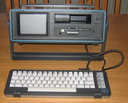
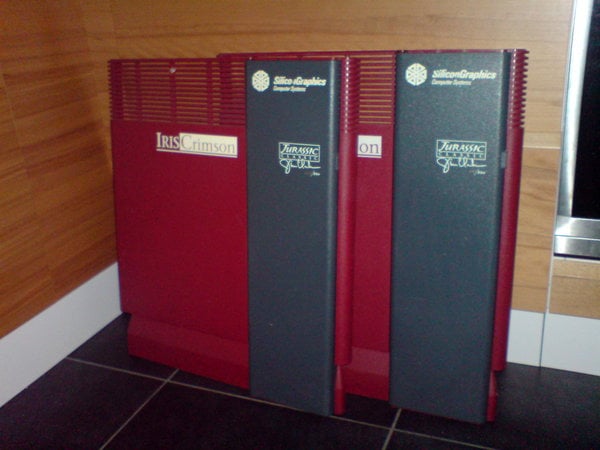
 . Unfortunatelly not totally unexpected, and it ended in
. Unfortunatelly not totally unexpected, and it ended in




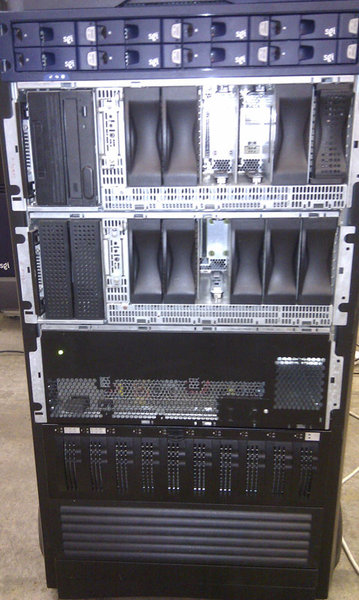
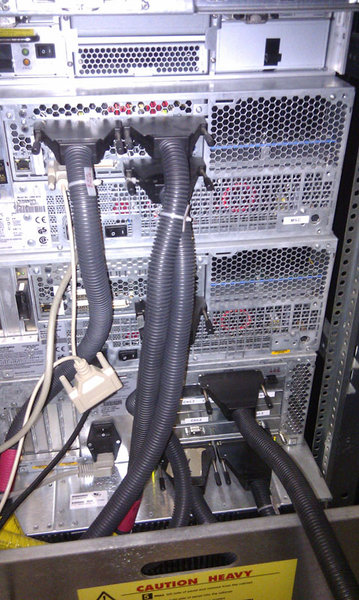
 so today I decided to take it easy and
so today I decided to take it easy and

